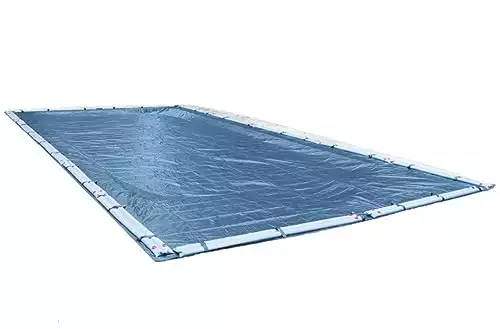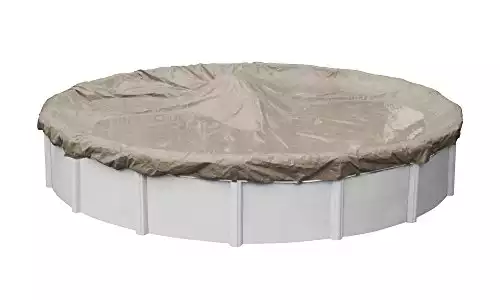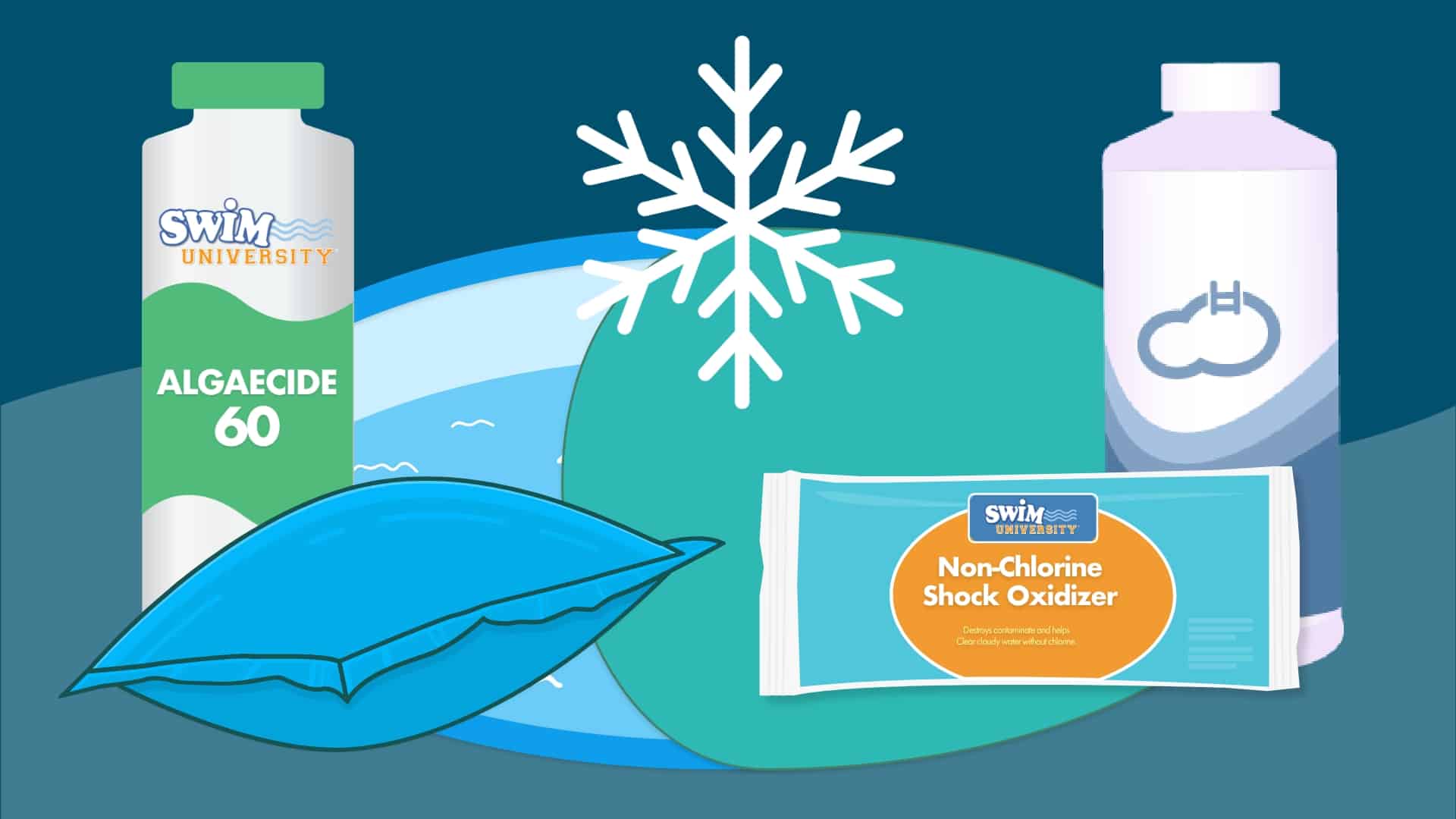The Best Winter Pool Covers in 2024 (Inground and Above Ground)
We picked the best winter covers for both inground and above ground pool owners based on industry insights. And determined the best ones for every type of pool in every climate.
Each one will keep out dirt and debris, reduce the number of opening chores, and protect the pool from damage. But before we reveal the best covers, let’s break down each type of pool cover and which ones are best for winterization. 👇
Stop wasting time and money with confusing water chemistry and maintenance. Our effortless system guarantees to keep your pool balanced, sanitized, and crystal clear all year. Works for all pools including saltwater.
4 Types of Swimming Pool Covers
What’s the difference between a winter pool cover and any other type of pool cover? It’s easy to explain:
1. Winter Pool Safety Cover (Inground Only)
A strong cover secured by pins or ties, it lies flat over an inground pool. It’s pulled taut and comes in either solid or mesh. While it does keep debris out, its primary purpose is to prevent people and animals from falling into the pool. Plus, it looks much nicer on the pool during the winter.
However, this cover is only for inground pools and requires installation. Holes are drilled into the concrete deck around the pool to keep the cover in place and safe. Here’s what it looks like:
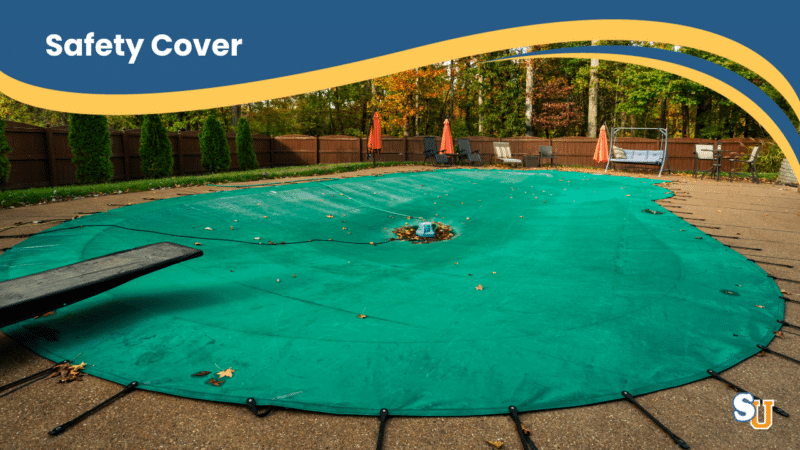
2. Winter Pool Cover Tarp (Most Popular)
A plain cover (sometimes even just a tarp) laid over either an inground pool or above ground pool. On an inground pool, it’s secured with water bags and water tubes (more on this later). On above ground pools, a winter cover sits on top of the pool water and is secured to the walls with cable tied through grommets and tightened with a winch.
Its purpose is to keep debris out of the water while the pool is closed, and it offers little to no safety benefits. But it’s the cheapest option. And I’ll tell you the best one to buy.
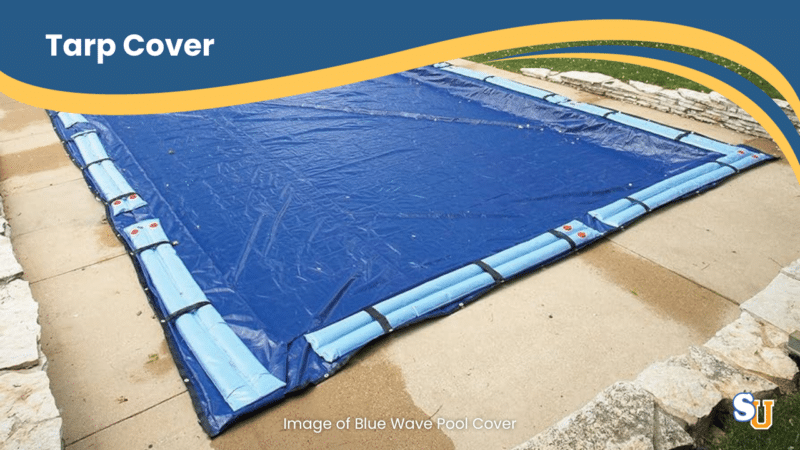
3. Automatic Pool Cover (Inground Only)
An inground cover deployed by an automated mechanism. It sits very close to the top of the water, and below the lip of the pool. This cover is meant to keep debris out of your pool during the swimming season. However, this is not recommended as a winter cover.
If you have an automatic pool cover, then I recommend investing in a winter safety cover if you close your pool to protect it. Here’s more information on the best automatic pool covers.

4. Solar Pool Cover
A blanket made up of bubbled plastic (it looks like bubble wrap). It sits directly on top of the swimming pool surface and concentrates solar energy to heat the water below it.
It also helps reduce water evaporation and keeps debris out. But it will not work well in the colder months and is not recommended as a winter cover. Here’s more information on the best solar pool covers if you’re interested.

The Best Safety Cover for Inground Pools
I highly recommend investing in a dense mesh cover by Loop-Loc. They’re the original creators of the pool safety cover and offer the highest quality cover in the industry.
They’re not cheap, but worth the investment. They are the best, in my opinion. And I promise you won’t be disappointed working with them. Just make sure you hire a certified Loop-Loc cover installer to get the most out of the warranty.

If you have a standard-size rectangle or round pool, the process of getting a new cover installed should be pretty quick. Safety covers can be any size and shape. So if you have a custom-designed pool, you will need to have an installer measure it before they make the cover for you.
NOTE: If you have a walk-around deck on your above ground pool, you might be able to invest in a safety cover. Reach out to Loop-Loc to see if your pool qualifies.
The cover color here doesn’t matter. It’s purely a design choice. But color does matter if you’re looking for the best winter pool cover tarp (keep scrolling to find out more).
If you need more information before investing, here’s our detailed guide on pool safety covers.
Solid Vs. Mesh: What is the Best Pool Cover?
I recommend going with a mesh safety cover. Solid covers are great because they keep debris and water out of your pool. But water will collect on top of the cover, causing it to sag from all the weight. You have to pump the water off the top of the cover with a winter cover pump (or submersible pump).
Once the water is off the cover, you still have soggy debris to deal with. You’d have to wait until it was completely dry to remove it.
This is also not safe for children. Small children can drown in very shallow water. So if you’re not diligent about removing rainwater and snow melt as soon as it happens, you could have a safety issue.
However, mesh covers allow rainwater and snow melt to drain into the pool while keeping debris out. The debris will dry on its own and it’ll be much easier and faster to remove.
You still need to pump extra water out, but not from the cover. You can simply stick a pump under the cover near the steps to pump out the excess water if needed.
The Best Winter Cover (Tarp) For An Inground Pool
Below, we found links to the best inground pool cover on Amazon. If you click the link and purchase it, we get a commission at no additional cost to you. But here’s why we chose it and how you can find a similar one at your local pool store.
This solid winter pool cover, designed for in-ground pools, ensures no water seepage with its impermeable material and includes a generous 5-foot overlap for easy installation. Constructed with a heavy-duty 8 x 8 scrim, the cover promises durability and comes with a 10-year warranty.
When you’re shopping for an inground pool cover, you want to look for a larger scrim count (8×8 or higher). Green covers tend to be of higher quality (but there are exceptions to this general rule). Thicker covers will hold up in the winter months to the elements.
TIP: Another factor you can look for when shopping for a cover is the length of the warranty. Thicker covers tend to have a longer warranty. Cheaper covers will give you an 8-year warranty, but you can find covers with up to 20 years.
Also, birds will often land on your cover and drink the rainwater and snow melt. When they land, their claws and beaks will puncture the cover. You can help avoid these tiny holes over time by investing in a thicker green winter pool cover. Blue covers tend to be less thick. So, if you want to save money and don’t mind buying a new cover every few years, you can go with that.
NOTE: When shopping for the correct size, note that you want to pick a cover that’s the exact size of your pool. Most winter pool covers are made 4 to 5-feet bigger to go over your concrete or wood deck.
If you want an extreme budget option, they make black trash-bag-like tarps that come in huge rolls. These are annual disposable covers. You will need to buy this type of cover every single year. But it’s the cheapest option out there—just not the best option.
The Best Winter Cover (Tarp) For An Above Ground Swimming Pool
Below is the best winter pool cover on Amazon. It comes in multiple sizes and is the highest-quality cover that’ll last for many years.
This cover has a solid, water-impermeable fabric. The design includes a 4-foot overlap for easy installation. And comes complete with a winch and cable system to ensure a secure fit through the integrated grommets.
Most above ground winter pool covers come with at least a 4-foot overlap, built-in grommets (holes around the edge), and a cable/winch system to tighten it down on the pool.
When you’re shopping for a cover locally, look for a cover with a high scrim count (8×8 or higher). And usually, when a cover has a warranty of over 12 years, it’s a good quality cover.
If you have a deck attached to your pool, you’ll also need to buy some water bags or tubes to keep the cover in place. The cable and winch that comes with the cover will have to be strung under the deck. Here’s some more information about how to secure the cover and keep it from sagging.
Frequently Asked Questions About Winter Pool Covers (FAQs)
I’ve compiled all the best questions we get asked about buying and taking care of a winter pool cover. Here are our responses.
What is the best cover for a pool in the winter?
The best cover for a pool in the winter is a quality, tight-fitting winter pool cover that’s capable of withstanding the elements. Look for one that’s made from a durable material like woven high-density polyethylene, which should have UV inhibitors to prevent sun damage. These covers keep out debris, reduce algae growth, and can handle the weight of snow and ice.
Do you really need a winter pool cover?
Absolutely, unless you’re a fan of swimming in a leafy, bug-filled ice rink. A winter pool cover protects your pool from debris, reduces maintenance, and prevents algae by blocking out sunlight. It’s like a security blanket for your pool – it gives you peace of mind during those cold months.
Is solid or mesh winter pool cover better?
Solid covers block out all light and debris, making them great for keeping the pool clean and algae at bay. However, they can collect water on top, so you’ll need a pump. Mesh covers, on the other hand, allow water to pass through while still keeping out leaves and twigs, meaning less maintenance. Your choice depends on your priorities: cleanliness or convenience.
What’s the difference between a winter pool cover and a regular pool cover?
Winter pool covers are the heavy-duty versions of regular pool covers. They’re built to withstand harsher conditions like snow load, ice, and strong winds, while regular covers are more for everyday use during swimming seasons to keep out debris and maybe retain some heat.
What is the best material for a pool cover?
The best material for a pool cover is a tough call – it’s like asking what’s the best cheese for a pizza. But if you’re looking for longevity and performance, go for a reinforced polyethylene or polypropylene cover. They’re strong, resist tears, and handle UV exposure like champs.
Should winter pool cover be tight or loose?
Your winter pool cover should be snug but not as tight as your favorite pair of jeans after Thanksgiving dinner. A little give is necessary to handle snow and ice weight without the cover tearing or the supports breaking. But if it’s too loose, and it’ll flap around like a superhero’s cape in a hurricane.
Should winter pool cover be black or green side up?
If your winter pool cover has a black side, that should generally go down, facing the water. This can help absorb heat to prevent freezing and inhibit algae growth. The green side, assuming it’s the designed top, likely has UV protection and should face up, ready to face the sun.
How thick should a winter pool cover be?
A winter pool cover should have enough thickness to withstand snow and ice, typically around 12 to 16 mils. Thickness equates to strength, like a weightlifter’s biceps. You want it beefy enough to handle the heavy lifting of winter’s worst.
What is the cheapest way to cover a pool?
The cheapest way to cover a pool is with a basic tarp-style cover. It’s not fancy, but it gets the job done. Just make sure you secure it well, or you’ll find it dancing around your backyard like a runaway kite.
Is a mesh pool cover worth it?
A mesh pool cover is totally worth it if you hate the idea of pumping water off the top of a solid cover. It lets water through while keeping out the big stuff and makes for an easier spring opening. Think of it as the casual Friday of pool covers – less formal but still does its job.
Why put a pillow under the pool cover?
You put a pillow under the pool cover to help manage rainwater and melting snow, which can pool in the center and stress the cover. The pillow creates a slight dome shape for drainage – think of it as a little hill in the middle of a valley.
How long should a winter pool cover last?
A good winter pool cover should last you several seasons if you take care of it. Usually, you can get about 5 to 10 years out of a top-notch cover. It’s a marathon runner – with proper care, it goes the distance.
How do I keep my winter pool cover from sagging?
To keep your winter pool cover from sagging, make sure it’s properly secured and evenly tensioned. Use a cover pump to remove excess water and consider an air pillow to promote runoff. It’s like preventing your tent from sagging – everything needs to be tight and just right.
3 Ways We Can Help With Your Pool
- Pool Care Cheat Sheets (Free): Easy-to-use downloadable guides to help you keep track of taking care of your pool this year.
- The Pool Care Handbook: An illustrated guide to DIY pool care, including water chemistry, maintenance, troubleshooting, and more.
- The Pool Care Video Course: You’ll get 30+ step-by-step videos and a downloadable guide with everything you need to know about pool maintenance.


